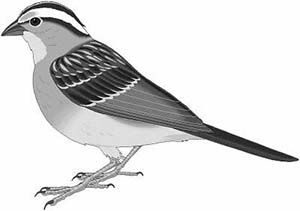Comparing a Human and Avian Skeleton
 The avian (bird) skeleton has many features that resemble the human skeleton, and the majority of the bones are the same, they are only shaped different. When structures are similar in different organisms, they are called homologous. The main difference between the human and bird skeleton is that the bird's skeleton is adapted for flight. For instance, the bones of a bird are hollow which makes the skeleton lighter. The collarbone of the bird is fused for stability and is called the furculum.
The avian (bird) skeleton has many features that resemble the human skeleton, and the majority of the bones are the same, they are only shaped different. When structures are similar in different organisms, they are called homologous. The main difference between the human and bird skeleton is that the bird's skeleton is adapted for flight. For instance, the bones of a bird are hollow which makes the skeleton lighter. The collarbone of the bird is fused for stability and is called the furculum.
The arm bones of the human consist of the humerus, the radius and the ulna. These bones are also found in the bird. On both skeletons, color the humerus (G) pink  . Color the radius (F) green and the ulna (E) light green
. Color the radius (F) green and the ulna (E) light green  .
.
The leg consists of a long femur which attaches to the pelvis and then two bones of the lower leg. In the bird, these two bones: the tibia and fibula are fused together. In humans, they are separated. You are probably familiar with the tibia of the bird, that's the part you eat called the drumstick. When you eat the thigh of the bird, the bone within it is the femur. On both skeletons, color the pelvis (M) yellow, the femur (N) orange, and the tibia (O) light blue  . On the human only, color the fibula (P) dark blue
. On the human only, color the fibula (P) dark blue  . Also on the human skeleton, the patella, also called the kneecap is visible. Color the patella (S) green
. Also on the human skeleton, the patella, also called the kneecap is visible. Color the patella (S) green  .
.
The head of both birds and humans is protected by a large cranium. The upper jaw of the human, and the upper beak of the bird is composed of a bone called the maxilla. The lower jaw and lower beak is composed of a bone called the mandible. On both skeletons, color the cranium (A) red, the maxilla (B) grey, and the mandible (C) pink  .
.
The differences between the bird and human skeleton are very apparent in the pectoral girdle, which is the place where the forelimbs attach to the spine. The bird's forelimbs are wings and must have a strong support system. The collarbone of the bird is fused to form the furculum, or wishbone. The "shoulder blade" of the human is actually a bone called the scapula, birds have a scapula and they also have an additional shoulder bone called the corocoid. On both skeletons, color the scapula (K) dark brown. On the bird, color the furculum (J) black and the corocoid (L) light brown. On the human, color the collarbone (J) black  .
.
Another obvious difference between the human and bird skeleton is the shape and size of the sternum. A bird's sternum is large and positioned under the body - flight muscles attach to this bone. The ridge of the bird's sternum is called a keel. The ribs are attached to the spine and to the sternum. On both skeletons, color the sternum (H) red and the ribs (R) blue  . On the bird, trace the edge of the sternum in green to show the keel (I)
. On the bird, trace the edge of the sternum in green to show the keel (I)  .
.
The vertebrae of the bird and human are similar except for the bone where the tail feathers attach, called the pygostyle. Humans have a tailbone that is similar, but it is not pictured. Color the vertebrae (D) yellow and the pygostyle (Q) purple  .
.
Questions:
1. Define homologous._______________________________________
2. Name two ways in which the bird's skeleton is adapted for flight.________________________________________________
3. What bone is the drumstick? ______________________
What bone is the wishbone? __________________________
4. What two bones make up the bird's beak? _______________________________________
5. What three bones make up the bird's forelimb? ____________________________________
What two bones make up the bird's hind limb? ____________________________________
6. The pectoral girdle is the area of the skeleton that attaches the arm bones to the spine. In humans the pectoral girdle consists of the scapula and the clavicle (collarbone). What three bones make up the pectoral girdle of the bird? _______________________________________
7. The patella is also called the ___________________________
8. The “thigh” of the bird contains what bone? ___________________________
9. What is the scientific name for the “shoulderblade”? _______________________
10. The tail feathers attach to what bone? ___________________________
11. List two bones you will find in a bird, but not in a human. _______________________________
12. List two bones you will find in a human, but not in a bird. _____________________________
13. How many bones are in a human’s leg? _______ In a bird’s? __________
How many bones are in a human’s arm? _______ In a bird’s wing? _________
The longest bone in the bird’s leg is the __________ In a humans? __________
14. Next to each letter on the HUMAN skeleton, write the name of the bone.

Other Resources on Birds
Birds: Form, Function, and Classification - slides and outline on birds
Bird Beaks and Feet - view pictures of birds, make inferences about their diet and habitat
Animal Reproduction and the Amniote Egg - color the amniote egg and identify the main structures; compare to human reproduction
Bird Digestive System - label a diagram


